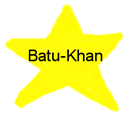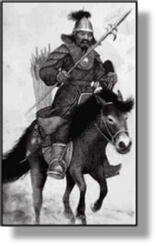


THE EXPANSION OF THE MONGOL EMPIRE UNDER BATU 1241 (H3)
xxxxxAs we have seen, Genghis Khan became ruler of the Mongols in 1206 (JO). By the year of his death, 1227, his empire stretched from the Black Sea in the west to the Yellow Sea in the east, and from Siberia in the north to the edge of South East Asia in the south -
 xxxxxAs we have seen, Genghis Khan became ruler of the Mongol peoples in 1206 (JO) and seven years later embarked upon a military campaign which was to create an empire stretching over vast tracts of Asia. He began his conquest of northern China in 1213, had captured Peking by 1215, occupied the Korean peninsula by 1218, and, before invading India and Russia, had conquered Khwarezm, a vast empire stretching across modern Iraq and Iran and parts of Turkestan. When he died in 1227 after falling from his horse, his territory extended from the Black Sea in the west to the Yellow Sea in the east, and Siberia in the north to the northern borders of South East Asia in the south. It was, in fact, the largest area that any one man has ever controlled.
xxxxxAs we have seen, Genghis Khan became ruler of the Mongol peoples in 1206 (JO) and seven years later embarked upon a military campaign which was to create an empire stretching over vast tracts of Asia. He began his conquest of northern China in 1213, had captured Peking by 1215, occupied the Korean peninsula by 1218, and, before invading India and Russia, had conquered Khwarezm, a vast empire stretching across modern Iraq and Iran and parts of Turkestan. When he died in 1227 after falling from his horse, his territory extended from the Black Sea in the west to the Yellow Sea in the east, and Siberia in the north to the northern borders of South East Asia in the south. It was, in fact, the largest area that any one man has ever controlled.
xxxxxOn his death the empire was divided among the sons of his primary wife, as was the custom, and four Khanates or kingdoms came into existence: the Great Khanate (later led by Kublai Khan), the Hulagu Khanate in Persia, the Chagstai Khanate in Turkestan, and the Khanate of the Golden Horde, later established by Batu Khan in southern Russia.
 xxxxxUnder Genghis Khan's successor, Ogodei, expansion continued at a rapid pace. The Emperor himself launched an attack on the Chin dynasty of northern China, a task continued by Kublai Khan in 1251, whilst in the west, Batu-
xxxxxUnder Genghis Khan's successor, Ogodei, expansion continued at a rapid pace. The Emperor himself launched an attack on the Chin dynasty of northern China, a task continued by Kublai Khan in 1251, whilst in the west, Batu-
xxxxxElsewhere, as we shall see, in 1258 another grandson of Ghengis Khan, Hulegu, was busy extending Mongol rule into the world of Islam, and in 1260 Kublai Khan was about to embark on the conquest of China.
H3-
Acknowledgement
Batu: date and artist unknown.


